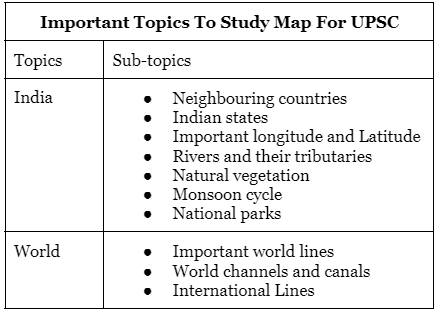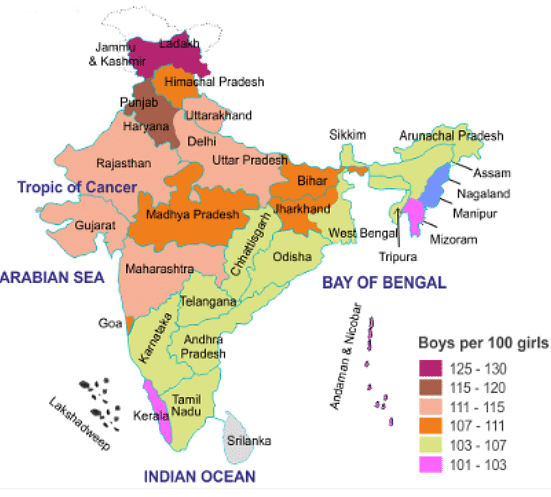How To Study Maps for UPSC CSE | Geography for UPSC CSE PDF Download
Maps for UPSC Preparation are an essential part of the learning strategy. Owing to this reason, the maximum number of questions in the exam are based on the History and Geography of India and the world. A lot of questions based on maps are framed every year. Not only for the written exam but maps act as an essential element for the UPSC Interview round too. Studying maps for UPSC Exam and having complete knowledge of them is also helpful in learning the current affairs section with ease. However, most of the students who are new to the UPSC Preparation, often struggle to study maps effectively.
Map for UPSC Preparation: Important Topics
- Before learning, the candidates must first think and analyse what topics are important to prepare in maps. As per previous year’s questions, most of the questions in the maps are asked from India and the world. The candidates should first prepare those topics that have been previously asked in the exam to be exam-ready. We have compiled a list of topics, candidates can cross-check the same and start their preparations:

How To Study Map for UPSC?
- Various factors & tactics need to be considered to study the map for UPSC Preparation so that it gets easy to analyse and remember the maps. Let’s understand important points to understand the methods to study maps for UPSC Exam.
How to Cover each topic in Maps for UPSC IAS 2024?
- A well-defined strategy would be helpful in covering the aforesaid mentioned topics for Maps. One of the most important things to keep in mind while studying maps is keeping the mind attentive. Then, follow the topic-wise strategy mentioned in the space below to ace this section.
How to Study the Political Map of India?
- The maximum number of questions in the maps section for UPSC IAS 2023 are asked based on India. It is hence, really crucial to know this section well and cover each subtopic before moving to the world map.
Neighbouring countries
- Make pointers related to all neighbour countries.
- Note down the names of the important borderlines.
- Give preference to the countries situated in the Indian subcontinent.
- Mark major degrees, ocean names, peninsula etc for all of these countries.
Indian States
- Develop the skill to make the Indian political map in at least 30 minutes
- Study each state along with their coordinates, major crops, animals
- Incorporate current affairs while studying states and give more focus to state that has been in news recently
Important Longitude and Latitude
- Mark important states that are situated in the major lines of the country
- Note down the longitude and latitude of major states. Take the help of previous year papers to know which states have been given more importance over the years.
- Try to study more about coastlines, peninsular lines etc.
For example, you have to show the sex ratio in the political map of India and locate the states like Madhya Pradesh, Rajasthan, Maharastra, and Gujarat. See the map below.
How to Study the Physical Map of India?
The physical map of India can be studied by keeping the following pointers in mind.
Rivers and their tributaries
- Draw river drainage basin and mark all major tributaries related to the rivers
- Study and mark the origin, routes, tributaries, states on the banks of the rivers, state that these rivers are crossing etc.
- Repeat this process for every state in the country.
For example, you have to show the drainage pattern of the River Ganges on the map of India. See the map below.
 Natural Vegetation
Natural Vegetation
- Study the natural vegetation of the country and state
- Mark the major crops like Rabi and Kharif Crops, forests (for eg: Tropical Deciduous and Evergreen Forest, Tropical Rain Forests, Montane Forests and more), etc for a particular state and then go state-wise, subsequently covering the entire country.
Mountains
- Begin with covering the Himalayas and note down the major & highest mountain peaks of the various Himalayan ranges. Then, move to the other mountain ranges and cover the same. Try to cover the major national parks, flora and fauna associated with these.
- Locate the major glaciers of the state and also try to mark the major mountain ranges and glaciers etc.
National Parks
- Locate the major parks, wildlife sanctuaries, tiger reserves, biosphere reserves etc for a particular state. Try to mark all these on the political map of India.
How to Study World Map for UPSC?
- Study and mark the coordinates of major lines, Tropic of Cancer, Tropic of Capricorn, Arctic Circle, and the Equator. Also, study important lines i.e. Prime Meridian and International Date Line.
- Mark countries, capitals, important cities, and ports that have been in the news lately.
- Mark examples of major biodiversity hotspots and conversation areas around the world.
- Make a note of the important physiographic features around the world. Mark them on a physical or a political map.
- Mark major countries and international projects associated with them.
- Major news locations, and order on the map (North-South or East-West), for example, Afghanistan, Albania & Angola.
- Also, understand the location of the Rocky Mountains, Lake Baikal, the Alps, the Ural Mountains, and other major geographical features. Mark the nations through which the Amazon or Nile River flows.
Helpful Tricks to Draw Maps UPSC Preparation
We have put a lot of emphasis on drawing maps easily within 30 seconds. However, there are a lot of tips and tricks that help in doing so. We have mentioned some of the best methods that could help in drawing Indian maps easily for UPSC CSE 2024:
- Buy blank India political maps. Make sure to keep a stack of maps ready for practice whenever you need.
- Indian Standard Meridian and Tropic of Cancer can be your guidelines to begin. Then draw the subcontinent.
- Next, draw the Kutch and Kathiawar peninsulas.
- Once done, mark the northern and eastern borders of the country.
- Next, mark the major towns, cities, important lakes, and major ports on the eastern and western coasts and draw all the neighbouring states.
- Mark states with bigger areas i.e. Jammu and Kashmir, Punjab and Rajasthan and so on. Mark all the states on the map along with their capitals.
- Next, draw the Andaman and Nicobar islands, Lakshadweep island and Sri Lanka.
- With the basics of the Indian political map now mastered, you can move on to the physical map and start marking the major mountain ranges, rivers and tributaries on the map.
- Feel free to use colours to differentiate.
- Try marking as many features as possible on the same map, as cleanly and clearly as possible.
Preparation Strategy for Mastering Maps for UPSC
Following the preparation strategy mentioned below can help master the maps questions for the UPSC IAS 2024:
- Begin with buying a good quality Atlas you can always go for the one recommended by previous year students. The atlas should be such that every topic like rivers, oceans, and currents is available in it in the most appealing manner to retain them for a longer period of time.
- Master the basic maps in the beginning i.e. country, world and then go for the tougher ones like rivers, terrains, currents etc. Practice a lot so that you are able to draw a map within 30 seconds or less. You can also use things the other way, like if you are reading about a state then mark the historical events that may have happened there.
- Practice previous year questions based on maps and check if you are able to solve them. Although this is the oldest technique, it is useful as it helps in knowing the preparation level of the candidate.
- Revision is one of the best things that a candidate can do to ace up his preparation levels. Make a list of all the important topics and revise them by practising on a daily basis.
Benefits of Studying Maps for UPSC (Mains)
Many reports have claimed that studying with images or visual effects may help retain memory for a longer period. Hence, maps prove beneficial in remembering historic dates or events for a longer period. The following are the major benefits of studying maps for the upcoming IAS Mains 2024:
- Maps are one of the best ways to study the geopolitical conditions of a country. It also helps in pinpointing major historical events. History is one of the most crucial subjects in the UPSC IAS 2023. Maps are one of the best ways to learn the land routes, coastal routes and other geographical locations of the country.
- The second benefit that maps provide to the candidates is it helps in study world history with ease. While studying for a particular historical topic, if the candidates use the map then it will help in learning about the geographical locations of all the countries that were important in that event.
- Current Affairs are one of the most important sections of the UPSC IAS 2023 exam. The candidates have to cover a lot of important factors such as visits of heads of the country, agreements signed, and major news or events happening in these countries. Coupling the learning process with maps will not only help in devising a visual experience but also help the candidates in knowing the geographical locations of the countries.
|
175 videos|624 docs|192 tests
|
FAQs on How To Study Maps for UPSC CSE - Geography for UPSC CSE
| 1. How can I effectively prepare for the map-based questions in the UPSC exam? |  |
| 2. Are there any specific topics that I should focus on while studying maps for the UPSC exam? |  |
| 3. Can you suggest any helpful tricks or techniques to draw maps accurately for the UPSC exam? |  |
| 4. Is it necessary to memorize every detail on the map for the UPSC exam? |  |
| 5. Where can I find good study materials or resources for map preparation for the UPSC exam? |  |






















